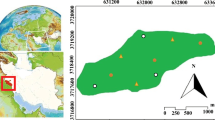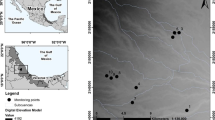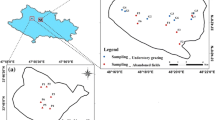Abstract
We sought to quantify early species succession (covering a 9 year period) after a natural wildfire in an unmanaged Mediterranean-type ecosystem across three different soil types. We examined different indices that are frequently used in literature as for their sensitivity and ability in tracing vegetation changes during a post-fire succession. Field data from a forest in Sithonia peninsula, northern Greece, during a period of 10 years after a fire event were used as a case study. In order to detect the best model fit of diversity and evenness indices we used pseudovalues generated with the jackknife method. The index of evenness and diversity with the lowest coefficient of variation scores were selected as the ones with the best model fit. In order to select the abundance model with the best model fit we compared the difference of the observed abundances data from the jackknife-predicted ones using the Akaike information criterion. According to our results, in rich and medium soil types, the best diversity ecosystem index from the ones examined was the (inverse) Berger–Parker one, while in poor soil types the Simpson or Brillouin diversity index. According to our results, in rich and medium soil type Mediterranean ecosystems, a good biodiversity ecosystem descriptor is based on how abundant is the most abundant species. In poor soil types where there are fewer species, and the percentage of cover is lower, indices that account for the relative representation of species within the community structure are better biodiversity ecosystem descriptors. All evenness indices examined but the Smith–Wilson were good ecosystem descriptors. The abundance model that showed the best model fit was the log series one. The poor fit of the Smith–Wilson’s index suggests that in species poor ecosystems the number of species is more important than species variance.




Similar content being viewed by others
References
Anscombe FJ (1950) Sampling theory of the negative binomial and logarithmic series distributions. Biometrika 37:358–382
Arvesen JN (1969) Jackknifing U-statistics. Ann Math Stat 40:2076–2100
Capitanio R, Carcaillet C (2008) Post-fire Mediterranean vegetation dynamics and diversity: a discussion of succession models. For Ecol Manage 255:431–439
Cary GJ, Morrison DA (1995) Effects of fire frequency on plant-species composition of sandstone communities in the Sydney Region—combinations of inter-fire intervals. Aust J Ecol 20:418–426
Clements FE (1916) Plant succession: an analysis of the development of vegetation. Carnegie Institute of Washington, Washington
Cohen JE (1968) Alternative derivations of species abundance relation. Am Nat 102:165–172
Cowles HC (1899) The ecological relations of the vegetation on sand dunes of Lake Michigan. Bot Gazette 27:95–117, 167–202, 281–308, 361–391
Cowling RM, Rundel PW, Lamont BB, Arroyo MK, Arianoutsou M (1996) Plant diversity in mediterranean-climate regions. Trends Ecol Evol 11:362–366
Di Castri F, Mooney AH (1973) Mediterranean type ecosystems. Origin and structure, ecological studies 7. Springer, Berlin
Dornelas M (2010) Disturbances and change in biodiversity. Philos Trans R Soc B 365:3719–3727
Eisenhauer N, Milcu A, Allan E, Nitschke N, Scherber C, Temperton V, Weigelt A, Weisser WW, Scheu S (2011) Impact of above- and below-ground invertebrates on temporal and spatial stability of grassland of different diversity. J Ecol 99:572–582
Ferreira FC, Petrere M Jr (2008) Comments about some species abundance patterns: classic, neutral, and niche partitioning models. Braz J Biol 68:1003–1012
Field A (2009) Discovering statistics using SPSS. Sage, London. ISBN: 978-1847879073
Fineey MA, McHugh CW, Grenfell IC, Riley KL, Short KC (2011) A simulation of probabilistic wildfire risk components for the continental United States. Stoch Env Res Risk Assess 25:973–1000
Finegan B (1984) Forest Succession. Nature 312:109–114
Forster MA, Warton DI (2007) A metacommunity-scale comparison of species-abundance distribution models for plant communities of eastern Australia. Ecography 30:449–458
Gitay H, Wilson JB (1995) Post-fire changes in community structure of tall tussock grasslands: a test of alternative models of succession and a new ‘Three-phase’ model. J Ecol 83:775–782
Gosselin F (2006) An assessment of the dependence of evenness indices on species richness. J Theor Biol 242:591–597
Grime PJ (1979) Plant strategies and vegetation processes. Wiley, Chichester
Higgins CL, Strauss RE (2008) Modeling stream fish assemblages with niche apportionment models: patterns. processes, and scale dependence. Trans Am Fish Soc 137:696–706
Johnston A (1957) A comparison of the line interception vertical point quadrat and loop methods as used in measuring basal area of grass land vegetation. Can J Plant Sci 37:34–42
Jost L (2010) The relation between evenness and diversity. Diversity 2:207–232
Juan P, Mateu J, Saez M (2012) Pinpointing spatio-temporal interactions in wildfire patterns. Stoch Environ Res Risk Assess. doi:10.1007/s00477-012-0568-y
Kaltsas D, Trichas A, Mylonas M (2012) Temporal organization patterns of epigean beetle communities (Coleoptera: Carabidae, Tenebrionidae) in different successional stages of eastern Mediterranean maquis. J Nat Hist 46:495–515
Kempton RA, Taylor LR (1978) Q-statistic and diversity of floras. Nature 275:252–253
Konstantinidis P (1990) Examination and investigation of relations between physiographic units of forests of aleppo pine (pinus halepensis) in Sithonia Peninsula (Chalkidiki N. Greece) and presenting in plant communities. Scientific Yearbook of Department Forestry and Natural environment, Aristotelian University of Thessaloniki, Thessaloniki Volume LV’ No. 5
Koolaei SMV, Jalilvand H, Hodjati SM, Parsakhoo A (2011) Estimating the biodiversity of understory plant species in afforestation and land sliding areas of Alder stand. J Soil Sci Environ Manag 3:269–276
Krebs CJ (1999) Ecological methodology. Addison Wesley Longman, Menlo Park
MacArthur RH (1957) On the relative abundance of species. Proc Nat Acad Sci 43:293–295
Magurran AE (1988) Ecological diversity and its measurement. Croom Helm, London
Magurran AE, Henderson PA (2003) Explaining the excess of rare species in natural species abundance distributions. Nature 422:714–716
May RM (1975) Patterns of species abundance and diversity. In: Cody ML, Diamond JM (eds) Ecology and evolution of communities. Harvard University Press, Cambridge, pp 81–120
Miles J (1979) Vegetation dynamics. Chapmann and Hall, London
Miles J (1987) Vegetation succession: past and present perceptions. In: Gray AJ, Crawley MJ, Edwards PJ (eds) Colonization, succession and stability. In: 26th symposium of The British Ecological Society, Blackwell Scientific Publications, Oxford
Miller RG (1964) Trustworthy jackknife. Ann Math Stat 35:341–344
Motomura I (1947) Further notes on the law of geometrical progression of the population density in animal association. Physiol Ecol 1:55–60
Moustakas A, Sakkos K, Wiegand K, Ward D, Meyer KM, Eisinger D (2009) Are savannas patch dynamic systems? A landscape model. Ecol Model 220:3576–3588
Noble IR (1981) Predicting successional change. In: Mooney HA (ed) Fire regimes and ecosystem properties. Proceedings of the conference at Honolulu Hawaii, 1978. United States Department of Agriculture Forest Service General Technical Report, WO-26, pp 278–300
Pausas J (2004) Post-fire regeneration variability of Pinus halepensis in the eastern Iberian Peninsula. For Ecol Manage 203:251–259
Peet RK (1974) The measurement of species diversity. Annu Rev Ecol Syst 5:285–307
Pielou EC (1969) The measurement of diversity in different types of biological collections. J Theor Biol 13:131–144
Pielou EC (1975) Ecological diversity. John Wiley and Sons, New York
Pinheiro JC, Bates DM (2000) Mixed-effects models in S and S-PLUS. Springer, New York
Preston FW (1948) The commonness, and rarity, of species. Ecology 29:254–283
R Development Core Team (2010) R: a language and environment for statistical computing. R Foundation for Statistical Computing, Vienna
Raschke M (2011) Empirical behaviour of tests for the beta distribution and their application in environmental research. Stoch Env Res Risk Assess 25:79–89
Routledge RD (1980) Bias in estimating the diversity of large, uncensused communities. Ecology 61:276–281
Roy J, Sonie L (1992) Germination and Population Dynamics of Cistus Species in Relation to Fire. J Appl Ecol 29:647–655
Scholes RJ, Archer SR (1997) Tree-grass interactions in savannas. Annu Rev Ecol Syst 28:517–544
Schowalter TD (2006) Insect ecology: an ecosystem approach, 2nd edn. Academic Press, London. ISBN: 978-0120887729
Simpson GG, Roe A, Lewontin RC (1960) Quantitative zoology. Harcourt Brace and Co., New York
Smith B, Wilson JB (1996) A consumer’s guide to evenness indices. Oikos 76:70–82
Southwood TRE (1978) Ecological methods. Chapmann and Hall, London
Stephens MA (1974) EDF statistics for goodness-of-fit and some comparisons. J Am Stat Assoc 69:730–737
Stiling P (1999) Ecology: theories and applications, 3rd edn. Chapman and Hall, Englewood Cliffs
Studeny AC, Buckland ST, Illian JB, Johnston A, Magurran AE (2011) Goodness-of-fit measures of evenness: a new tool for exploring changes in community structure. Ecosphere 2:1–19
Sugihara G (1980) Minimal community structure—an explanation of species abundance patterns. Am Nat 116:770–787
Thompson MP, Calkin DE, Finney MA, Ager AA, Gilbertson-Day JW (2011) Integrated national-scale assessment of wildfire risk to human and ecological values. Stoch Env Res Risk Assess 25:761–780
Tilman D (1985) The resource-ratio hypothesis of plant succession. Am Nat 125:827–852
Tsitsoni T, Karagiannakidou V (2000) Site quality and stand structure in Pinus halepensis forests of north Greece. Forestry 73:51–64
Tukey J (1958) Bias and confidence in no quite large samples. Ann Math Stat 29:614
Vitousek P, Matson P, Cleve K (1989) Nitrogen availability and nitrification during succession: primary, secondary, and old-field seres. Plant Soil 115:229–239
Waite S (2000) Statistical ecology in practice. Prentice Hall, London
Wilson JB (1991) Methods for fitting dominance/diversity curves. J Veg Sci 2:35–46
Wilson JB (1993) Would we recognize a Broken-Stick community if we found one? Oikos 67:181–183
Wilson JB, Wells TCE, Trueman IC, Jones G, Atkinson MD, Crawley MJ, Dodd ME, Silvertown J (1996) Are there assembly rules for plant species abundance? An investigation in relation to soil resources and successional trends. J Ecol 84:527–538
Zahl JH (1977) Jackknifing an index of diversity. Ecology 58:907–913
Zavala MA, Espelta JM, Retana J (2000) Constraints and trade-offs in Mediterranean plant communities: the case of holm oak-Aleppo pine forests. Bot Rev 66:119–149
Acknowledgements
We thank Panayiotis Dimitrakopoulos and Alexandros Galanidis for their constructive comments. Comments of two anonymous reviewers considerably improved an earlier manuscript draft.
Author information
Authors and Affiliations
Corresponding author
Electronic supplementary material
Below is the link to the electronic supplementary material.
Rights and permissions
About this article
Cite this article
Matossian, A.D., Matsinos, Y.G., Konstantinidis, P. et al. Post-fire succession indices performance in a Mediterranean ecosystem. Stoch Environ Res Risk Assess 27, 323–335 (2013). https://doi.org/10.1007/s00477-012-0593-x
Published:
Issue Date:
DOI: https://doi.org/10.1007/s00477-012-0593-x




